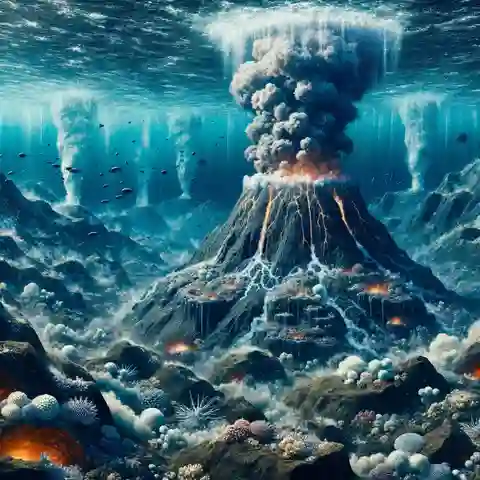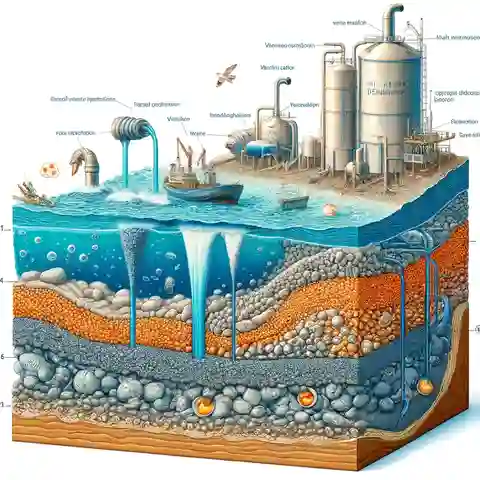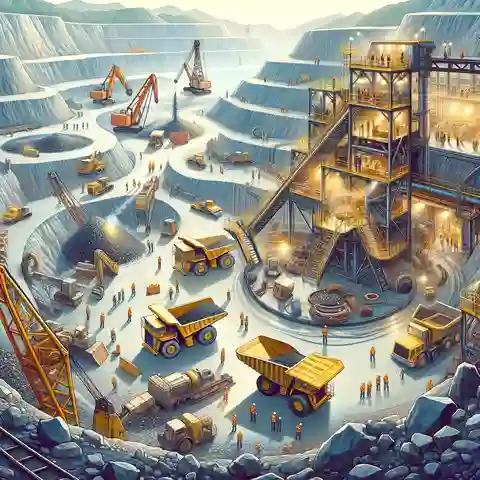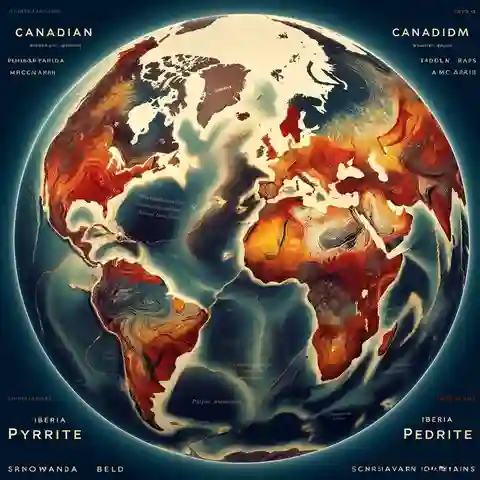VMS deposits in the world – Have you ever wondered where the metals in your phone or bike came from? Some of them might have been mined from a special kind of treasure trove called a VMS deposit. VMS stands for “Volcanogenic Massive Sulfide” – that’s a big word, but it just describes a big pile of valuable metals created by underwater volcanoes!
What are VMS deposits?
- VMS deposits are concentrations of valuable metals that formed long ago due to underwater volcanic activity.
- Think of them like buried treasure chests filled with metals like copper, zinc, lead, gold, and silver.
- These deposits formed when hot, mineral-rich water seeped through volcanic rocks, later spewing out of the seafloor and depositing the metals in concentrated layers.
Why are they important?
- VMS deposits are a major source of the metals we use every day.
- Copper from VMS deposits is in our electrical wires and plumbing.
- Zinc is used to protect steel from rusting and is part of batteries.
- Lead, gold, and silver have a wide range of uses in electronics, technology, and jewelry.
VMS Deposits in The World
Geologists, like treasure hunters, search for VMS deposits all over the world. These deposits are often found near ancient, worn-down volcanoes. Some famous hunting grounds include:
- Canadian Shield: Like a giant metal-rich puzzle spread across Canada
- Iberian Pyrite Belt: Spain and Portugal have been mining VMS deposits for centuries.
- Scandinavian Mountains: Vikings might have unknowingly walked over these treasures!
- Ural Mountains: A long mountain range in Russia with lots of hidden metal
- Tasman Belt: Stretches along the Australian coast
- Ocean Floor: We’re even finding active VMS deposits forming today!
How Volcanoes Make Metal: A Step-by-Step Guide

- Seawater Soaks In: Imagine a volcano erupting underwater. It makes a messy pile of cracked rocks. Seawater seeps into these cracks, just like a sponge soaking up water.
- Underground Oven: Deep under the ocean, heat from the volcano (and sometimes nearby magma) warms the water. Now it’s like extra-hot bathwater!
- Rock & Roll Cooking: The hot, slightly acidic water acts like a strong cleaning product, dissolving metals out of the rocks. Think about how lemon juice gets stains out – it works a bit like that!
- Metal Soup: As the water moves through the rocks, it picks up more and more metals. It turns into a cloudy, dark broth, packed with stuff like copper, zinc, lead – and even gold and silver!
- Eruption Time! The pressure of the hot water builds until it finds a way out. It shoots up through underwater vents called “black smokers” because they look like dark, underwater chimneys.
- Cooling and Settling: When the hot, metal-filled water hits the cold ocean, the metals start to clump together and fall out, almost like tiny metal snowflakes. This metal ‘snow’ covers the seafloor in a thick, muddy layer.
- Treasures in the Deep: Over a super long time – thousands or millions of years – that muddy layer hardens into rock. This rock is full of valuable metals and is called a VMS deposit. Eventually, it gets buried under newer layers, but clever scientists can still find it!
Important note: This process takes ages, and not every underwater volcano makes enough metal to be a worthwhile treasure.
Different types of VMS Deposits
Not all VMS deposits are alike. Depending on the types of volcanic rocks involved, you get different mixes of metal:
- Metal Mix Matters: VMS deposits aren’t all created equal. The specific mix of metals in a deposit depends on the types of volcanic rocks that were present when it formed.
- Mafic-dominated VMS: These deposits have lots of copper and zinc.
- Copper is fantastic for electrical wiring because it conducts electricity really well.
- Zinc is used to protect steel from rusting (think galvanized steel) and in the production of batteries.
- Felsic-dominated VMS: These deposits contain more zinc, lead, and silver.
- Zinc has the same applications as mentioned above.
- Lead has traditionally been used in batteries and radiation shielding, although its use is being phased out due to environmental concerns.
- Silver is used in electronics, jewelry, and even medicine!
- Bimodal-Mafic VMS: These deposits have a bit of everything – copper, zinc, lead, gold, and silver. This makes them valuable for a wide range of uses.
Why it’s Important: Knowing the type of VMS deposit helps determine:
- Mining priorities: Companies can focus on mining the deposits that contain the metals they need the most
- Processing techniques: Different metal mixes need different ways to be separated and refined
- Market value: Some metals are more in-demand and expensive than others, influencing the overall value of a deposit.
Exploration for VMS Deposits

Geophysical Techniques
- Gravity surveys: Dense VMS deposits have a slightly stronger gravitational pull than surrounding rocks. Special instruments can detect these tiny differences, hinting at buried treasure.
- Electromagnetics: VMS deposits are conductive, meaning electricity flows through them easily. Scientists can send electromagnetic signals into the ground and measure how they ‘bounce’ back, revealing potential deposits.
Geochemical Exploration Methods
- Soil and rock sampling: Analyzing the chemical makeup of soil and rocks for traces of metals associated with VMS deposits can highlight target areas.
- Water sampling: Streams and groundwater might pick up traces of metals leaching from hidden deposits.
- Drilling’s Role: Once a potential spot is found, drilling is the ultimate test. Drills bring up cores (cylinders) of rock, which are analyzed. This confirms the presence of a VMS deposit and helps determine its size and grade (how much metal is in the rock).
Mining and Processing of VMS Deposits

- Open-Pit Mining: Used when the deposit is near the surface. It’s like digging a giant hole, extracting the ore layer by layer.
- Underground Mining: For deeper deposits, tunnels and shafts are dug to reach the ore. Miners then extract the ore and transport it to the surface.
- Ore Processing
- Flotation: Crushed ore is mixed with water and chemicals. Air bubbles carry valuable metal particles to the surface, while waste rock sinks.
- Smelting: The concentrated ore is heated to super-high temperatures to separate the metals from impurities.
- Refining: Further processing removes any last impurities to create pure metals.
Environmental Concerns
- Waste rock and tailings: Mining produces leftover rock and processing waste that can contain harmful substances. These need careful storage to prevent pollution.
- Acid mine drainage: When sulfides in the ore react with air and water, they can form acid that harms the environment.
- Habitat disruption: Mines take up land, potentially impacting wildlife and ecosystems.
Economic Significance of VMS Deposits

VMS deposits might be buried treasure, but they supply a whole lot of the metal we use every day! Here’s how much they help:
Helping the Whole World
VMS deposits might be hidden, but they give us a bunch of the metal stuff we use every day! Think about it:
- Copper: Wires in your house? About 6% of all that copper comes from VMS deposits.
- Zinc: Keeps cars from getting rusty, and it’s even in batteries. VMS deposits give us a lot of it – around 22%!
- Lead: It’s used less often now, but it’s still important for some things. About 9.7% comes from VMS deposits.
- Silver & Gold: VMS deposits aren’t just about work stuff – they have treasure too!
Jobs and Helping Towns
Mines built near VMS deposits need lots of different workers! Not just miners, but scientists, engineers, truck drivers, and even cooks and cleaners. All those people spend money in the town, helping shops and stuff. Mines also pay money to the town, which helps build better roads, power lines, and things everyone needs.
The Future: Metals and Staying Green
We definitely need the metals from VMS deposits, but mining can sometimes hurt nature. That’s why companies are getting better at doing it carefully, using less water and making less mess. Scientists are even getting super clever at finding VMS deposits in the world that won’t hurt plants and animals as much, like way down in the deep ocean.
The future is all about having the stuff we need, but getting it in a way that keeps the Earth healthy for everyone. Maybe you could even help with this one day!



